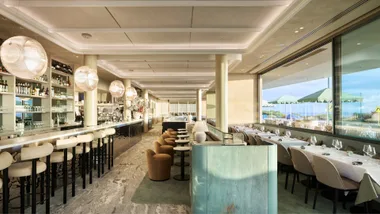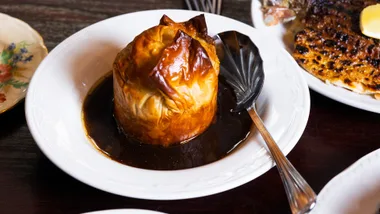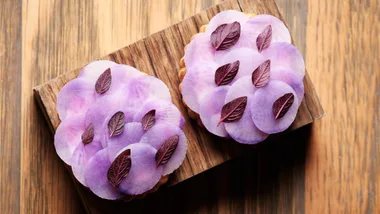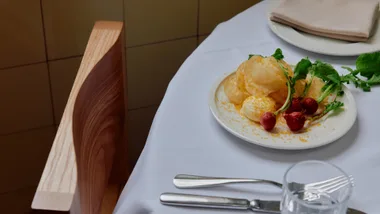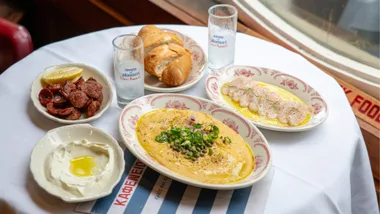IGNI
2 Ryan Pl, Geelong, (03) 5222 2266,
Licensed
Cards AE MC V EFT
Open Wed-Sat 6pm-11pm, Sat-Sun noon-4pm
Prices 5 courses $100, 8 courses $150
Vegetarian On request
Noise Expertly baffled
Wheelchair access Yes
Minus The Princes Freeway (for Melburnians, at least)
Plus Aaron Turner back to doing what Aaron Turner does best
For those up to speed with the origin story, seeing Aaron Turner in the open kitchen of his new restaurant, Igni, is an enormously satisfying conclusion to this part of the tale.
The story goes something like this. A young Turner, CV bulging with the likes of Noma and El Celler de Can Roca, returns to Australia to open a modest restaurant called Loam on an olive grove 90 minutes outside Melbourne with his then-wife Astrid. The approach – fiercely seasonal and regional with a menu that lists ingredients, not dishes – attracts popular and critical acclaim, a swag of awards (including GT’s 2013 Regional Restaurant of the Year award) and fanatical devotion from many diners.
After four years Loam unexpectedly closes. Personal reasons are cited and the chef, now single, exits Australia for Nashville. He returns almost two years later to open a Tennessee-style hot chicken bar in Melbourne. Then he parts company with his business partner and opens another chicken business in Geelong. Fans, who years after its demise still get misty-eyed when recalling Loam, are puzzled. Yes, the fried chicken is good, but the chef’s range is so much greater. What’s going on?
And then word of Igni arrives. Turner, joining forces with former Loam colleagues Drew Hamilton and Jo Smith, opens a dégustation-only restaurant with regional and seasonal philosophies similar to Loam, this time located in the gritty backblocks of Geelong’s CBD. It could go either way – a return to form or a slightly embarrassing exercise in glory-days nostalgia.
In the end it’s neither: at Igni, Turner’s cooking is better and more confident than it’s ever been.
The confidence is apparent almost immediately.
After negotiating the choice of five or eight courses (the number more guide than hard-and-fast rule), the meal begins with snacks. They’re the same snacks for every table, the only time during the meal you could be eating exactly the same thing as your fellow diners. It’s a wise move because missing any of these little flavour bombs would leave you feeling cheated.
Local saltbush leaves, fried crisp and then sprinkled with vinegar powder, are like hipster salt and vinegar chips, aesthetically pleasing and texturally interesting. Zucchini flowers are stuffed with pieces of pickled mussels and then grilled over charcoal. Squares of chicken skin are roasted to a cracker-like crunchiness and spread with a superb, citrusy cod-roe paste, while tiny ear-shaped slices of house-made guanciale and twig-like lengths of beef jerky (marinated in a mix of mushroom soy sauce, vinegar, grapeseed oil, and dried herb and fish paste before being dehydrated) round out the big flavours.
At Loam, Turner didn’t shy from complex technique, multiple ingredients and a cerebral approach to matching flavours. Those elements are present at Igni, too, but not all at the same time, on the same plate. Having few things going on all at once makes for food that’s more direct, and with more impact. Chuck in a dish as deliciously right/wrongas that wonderfully salty chicken skin and tarama number, and it’s clear that there’s fun to be had, too.
It’s a relaxed and assured start.
The room rolls the same way, though finding it in the lonely backblocks behind Geelong’s main drag can be an adventure given the minuscule signage and the fact Google maps was pinning the wrong location on Ryan Place (they’re trying to have that fixed). So the experience starts with a buzz from just tracking it down.
It’s a comfortable space sculpted out of a nondescript shell, all polished concrete floors and raw plywood ceiling with a wall of windows overlooking the narrow street partially screened by sheer charcoalgrey curtains. There are two bars, including a kitchen bar where the charcoal-grill focal point sits under a smart black and stainless-steel extraction canopy. Both have blonde timber stools with backs and seats upholstered in textured dark-grey fabric. The dining chairs around the bare timber tables are also blonde and upholstered, the fabric a lighter shade of charcoal. Rugs on the floor, indoor plants, abstract art on the walls and the modest size of the room (about 36 seats all up) all add to Igni’s particular charm: intimate, sophisticated, relaxed.
The lack of clutter in the place also means that sight-lines to other tables are good, so the great sport of dish-envy/gloating is a snap. Igni is a particularly apt arena for the game. There’s no menu, not even a list of ingredients, and while Turner has the makings for around 20 or so dishes every service, there’s never enough of any one ingredient to give everybody in the room the same dish. Menus are tailored to each table after a conversation with the floor staff, led with warmth and efficiency by Jo Smith and Drew Hamilton. They do a great job of keeping the conversation from feeling like an interrogation.
You might get a brilliant dish of raw calamari sliced into thin ribbons, tossed with tiny salty-sweet saltbush berries and finished with a marron and chicken broth poured at the table, but not the lightly grilled marron teamed with fermented pickled cucumbers and a Portuguese-style butter sauce flavoured with fish stock and sherry vinegar.
Or you might get char-grilled squab (replete with a Gothic-looking leg, claw on), roasted on the crown, served with wild plums and a wild plum sauce, but not the grass-fed Hopkins River beef hanger steak with cabbage fermented in goat’s whey. Damn it.
With any luck you’ll score the potato and society garlic dish that’s entirely capable of developing a cult following. King Edward potatoes appear as thin noodles, cooked in potato-starch water until just al dente, then tossed in garlic butter spiked with the purple flowers and stems from the society garlic plant (that taste like sweet garlic), mountain chives and crisp slices of organic garlic. Sweet and earthy, crunchy and slippery, it’s a small marvel of seeming simplicity.
King Edward potatoes and society garlic with chives.
It’s likely that you and your fellow diners will share a communal experience with the oyster dish, a good outcome all round. The two-bite dish is served in a white ceramic oyster shell that holds a lightly roasted oyster with a seawater emulsion made from oyster juices mixed with rice vinegar, Dijon mustard and grapeseed oil that’s frothy and salty like ocean foam. Sitting on the top is a leaf from the oyster plant, something Turner has grown for him exclusively. It’s a fleshy succulent leaf that tastes (yes) just like an oyster. It’s a fun dish, like a well-executed party trick.
The Igni wine list isn’t tricky, but it’s certainly well executed, a one-pager pulled together by Smith that changes almost daily to mirror the ever-changing moods of the menu. There’s a slight lean towards white wines displaying texture and subtlety, say a Mac Forbes 2015 “Spring” Riesling or a 2014 Gilbert Picq Chablis, while the red wine collection steers mostly towards the lighter side of the spectrum.
Igni also has an “off list” list that’s used for the (very reasonable) wine matchings they offer. It’s a good idea to ask about what’s hidden away because there’s interesting stuff to be discovered, perhaps a 2013 Beaumont Pinotage from South Africa or a savoury, slightly funky red-rice sake from Mukai Shuzo.
It’s a clever list and well priced, with everything under the $100 mark.
The dessert end of the meal starts with a cheese course, or more precisely a cheese – a cow- and goat’s milk number sealed with pig fat and hay that Turner makes in conjunction with nearby cheesemakers Drysdale Cheeses. It’s a nice touch, the homemade part, and the cheese is accompanied with slices of house-made pickled onion and wild onion flowers, but flavour-wise, it’s still a work in progress.
Not so with the desserts courses. There are two of them usually, but there’s an option to add to those. It wouldn’t be a terrible idea, particularly for those not after an avalanche of sugar. The wonderfully pretty “summer berries” is a colourful heap of fresh fruit – strawberries and blackberries alongside white mulberries and gooseberries – plus sugar-coated blueberries and small berry-like frozen balls made from berry coulis dropped into liquid nitrogen. Again, texture is a highlight, as is the custard, a non-bruléed crème brûlée number, that’s pooled under the berries.
The goat’s milk ice-cream is less flashily attractive but still a looker. Flavoured with seaweed, it’s sandwiched between crackers made from quinoa cooked to a paste that’s then rolled flat and dehydrated. The dish is topped with icing sugar mixed with dehydrated seaweed and has a salt-sweet quality that’s restrained, mature and very charismatic.
The name Igni may not exactly roll off the tongue, but it’s a good fit here with its nods to fire and ignition. Literally, it refers to the charcoal in the kitchen that features in so many of Igni’s dishes. But with Aaron Turner cooking as well as this after years away and a series of life-changing events, it’s hard to avoid the new-beginning, rising-from-the-ashes connotations.
Whichever way you want to take it, Igni is a name you should remember and a restaurant you should eat at. Time to pay Geelong a visit.

King Edward potatoes and society garlic with chives



